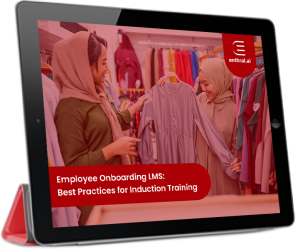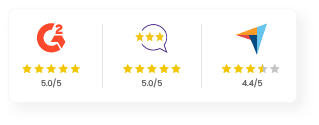Employee Onboarding LMS: Best Practices for Induction Training

When a new employee joins your organization, their first few days are super crucial. If you have a well-structured onboarding and induction process, they will feel welcomed, informed as well as ready to contribute from the get-go.
If you want to make your induction process exceptional, then a Learning Management System (LMS) is your best bet to offer a centralized, accessible and engaging onboarding experience.
Why a Strong Onboarding Process Matters?
The importance of an effective onboarding process extends far beyond just getting employees to fill out paperwork or watch introductory videos.
A well-executed onboarding program can increase retention by 82% and reduce time-to-productivity significantly. On the other hand, poor induction can lead to early turnover, job dissatisfaction, and a slow integration into the team.
When new hires don’t get any support or are unclear about their responsibilities, it creates a lasting negative impression that is hard to do away with. This is why a strong onboarding strategy (supported by an LMS) is important. Beyond introducing the company’s values and culture, onboarding sets the tone for how new employees will approach their roles and interact with colleagues.
Key Benefits of Using an LMS for Employee Onboarding
An LMS can totally transform how you handle onboarding.
Here’s how:
Automated Processes: An LMS automates the administrative side of onboarding, right from enrolling the new hires in mandatory courses (compliance, POSH) to tracking progress and completion. This reduces L&D and HR workload plus ensures nothing is missed.
Consistency Across Locations: For companies with multiple branches or remote teams, ensuring consistent onboarding can be a challenge. An LMS ensures that every new employee, regardless of location, receives the same high-quality onboarding experience.
Engagement through Interactive Learning: New hires can quickly lose interest in long, monotonous training sessions. An LMS can incorporate interactive elements like quizzes, discussion boards and video tutorials to keep them engaged.
Scalable Solutions: Whether you are onboarding one new employee or one hundred, an LMS can scale easily which makes it ideal for both small startups and large enterprises.
Best Practices for Using an LMS in Onboarding
1. Start Before Day One
An onboarding process actually has to begin even before the new hire’s first day. Using the LMS, employees can be given access to pre-hire resources, such as company handbooks, benefits information, and introductory videos about the team and culture.
What this early exposure does is it helps new hires ease their first-day nerves which means they are in a better position to hit the ground running.
2. Create a Structured Onboarding Timeline
An LMS helps guide employees through their first few months by setting specific milestones for them to achieve. From learning about company policies in the first week to completing role-specific training within the first month, breaking down the onboarding process into manageable chunks helps make sure the new hires don’t feel overwhelmed.
Each phase of the plan can be automated within the LMS so that employees know what they need to accomplish and by when. You can also set reminders for key tasks to ensure no important steps are overlooked.

How Max Enhanced their Onboarding Process
- Tailored Learning Journeys
- Multi-Language Support
- Just-in-Time Learning
- On-the-Job Training
Key Elements of Gamification in LMS
3. Centralize Resources for Easy Access
The LMS serves as a one-stop shop for all onboarding resources. This includes access to company policies, training documents, product knowledge materials and even frequently asked questions. Having a centralized location where employees can find everything they need reduces the need for constant back-and-forth with HR or IT.
A robust LMS also helps ensure that these resources are easy to navigate and clearly organized. You can also consider using multimedia content such as videos, infographics and interactive guides to make the onboarding experience more dynamic and interesting.
4. Use Interactive and Engaging Learning Modules
Traditional onboarding often involves dry presentations and intense paperwork. With an LMS, you can transform this experience by incorporating interactive elements that encourage active learning. Use gamification techniques like quizzes, badges, or point systems to motivate new hires to complete training modules.
You can even encourage interaction between new employees and existing staff by setting up discussion forums or arranging virtual Q&A sessions with department heads. These activities make the training more engaging plus build early connections within the company.
5. Incorporate Real-Time Feedback and Surveys
Feedback is an essential part of improving the onboarding process. Throughout their induction, employees should be given the opportunity to provide feedback on the training they have completed. This can be as simple as a quick survey at the end of each module or a more detailed questionnaire at the conclusion of their onboarding.
The LMS can also track which parts of the training are most or least effective, helping you focus on what works best.
6. Track Progress and Adapt Based on Data
One of the biggest advantages of using an LMS is the ability to track onboarding progress in real-time. L&D and HR teams can monitor which employees have completed their training, how long it took them and how well they performed. These insights can be of great use for identifying areas of the onboarding process that need improvement.
Summing Up
When you empower your new employees with the right tools and knowledge through a well-structured LMS-driven onboarding program, you set the stage for long-term success—both for the employee and the organization.
An LMS is a powerful tool that takes your onboarding and induction process to the next level. When you employ some onboarding best practices, your LMS ensures that your new employees are set up for success from day one.











